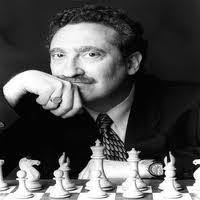
Pandolfini's Puzzler #30 - Castling in the Air
Professor: Hi there, class. I’m wondering if any of you have had an opportunity to castle today.
Zephyr: I haven’t even had a chance to play chess yet, Professor. How could I castle?
Lucian: Really? You haven’t played chess yet? Well I played chess this morning. I even castled four times. I played four games on ChessKid.com, winning all four. I even castled four times. I crushed them all.
Professor: It’s certainly reassuring to learn that not only did you crush your opponents, but you happened to castle in each case before bringing home the point.
Lucian: You know what they say, Professor, a chess player’s home is his castle. Or maybe instead of his castle I should say his rook.

Zephyr: Castle schmassel. Why not HER rook?
Professor: Ahem. I think we can put a halt to the English Shemenglish right now.
Zephyr: That sounds like a hint.
Lucian: Is it time to get to the problem, Professor? Hint hint?
Professor: Yes, that time is upon us. Please consider this position.
Professor: Here White has a material advantage and something else: a forced win. I think you’re ready for the big question.
Question 1: How can White force mate in two moves?
Lucian: This position reminds me of several others we’ve had in this class, especially with White’s king stationed so close to Black’s, possibly ready to help out in giving a support mate.
Zephyr: Or maybe even a back row mate, what the Professor sometimes calls a right triangle mate, where the two kings oppose each other and a queen or rook checkmates along an outside rank or file.
Professor: You know, sometimes the right triangle pattern turns out to be an isosceles triangle, but let’s not get into that. We’ll save that discussion for another occasion, when we have the time to go off on a tangent.

From here, smiling as partners in a joyous enterprise, the two puzzlers set out trying to find the solution. And they did. After a couple of minutes, they thought they had found an answer, but they had a question. Zephyr and Lucian wanted to know if Black had the right to castle, since that would clash with their answer. Seconds later, they had both understood the situation, and the professor congratulated them on their good work.
Professor: I’m terrifically impressed with the two of you. And because of how well you’ve handled matters, I’m going to give you both a present.
Zephyr and Lucian: What kind of present, Professor?
Professor: The only kind that should matter to serious chess players: another chess problem. Please cast your eyes on the following.
Professor: Playing off our first problem, allow me to set this one up accordingly. First of all, White can force mate in three moves. But there are two parts to the problem. Clearly, on the last move, Black must have moved either his king or one of his rooks.
Lucian: That seems right, Professor. Obviously, none of Black’s pawns could have moved.
Zephyr: Oh, pawns don’t go backward?
Professor: Ha! Moving on from that jocosity, I’d like the two of you to play detective. Let’s assume Black’s last move was a rook move. Let’s also assume that Black can still castle. Now figure out how to mate in three moves whether Black can castle kingside or queenside.
Question 2: From diagram two, can Black force mate in three moves?
In summary, answer question one and explain the reservation considered by the students. Then, answer question two, taking into account whether Black has previously moved the queen-rook or the king-rook. Good luck – you may need it.
Answer below - Try to solve ProfessorPando's Puzzle first!
ANSWER #30
The first problem is easy. White mates by 1. Qa1!, and Black is mated next move by a queen check on h8, unless Black could now castle. But Black can’t castle, however, since on the previous move he had to move either the king or rook – no other move was possible.
For the second position, let’s consider the options.
If the queen-rook has already moved (if the last move had been Ra8), White wins by 1. Qg5!, threatening mate at e7. The main line then is 1…Kd8 2. Qd5+ Kc8 (or 2…Ke8) 3. Qxa8 mate.
If the king-rook has already moved (if the last move had been Rh8), White wins by 1. Qd4!, threatening mate at h8. The main line then is 1…Rg8 2. Qd7+ Kf8 3. Qxe7 mate.
Take note
Some people might say the above two-part problem signifies a “twin” problem, but technically it does not. A twin problem refers to two different positions that are similar or strongly related, with different solutions. Here the solutions are different, but they play off the same setup (albeit with the pieces having different powers, based on which side castling is still legal). So the one position, having two different storylines preceding it, as charming as they may be, does not represent a true twin.
RELATED STUDY MATERIAL
- Take the Chess Lesson course on Castling and make sure you know all the strange rules;
- Watch FunMasterMike's sad story about forgetting an important castling idea when he was ChessKid!

